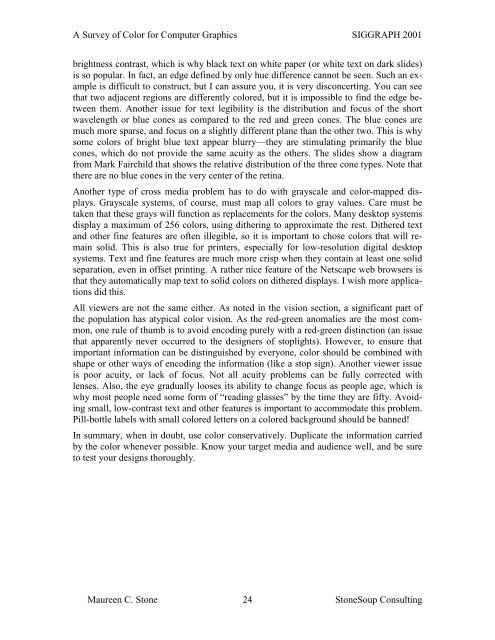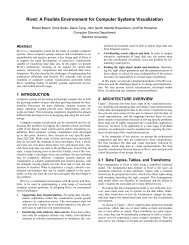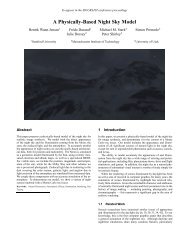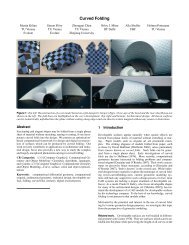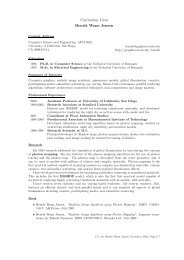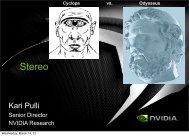A Survey of Color for Computer Graphics
A Survey of Color for Computer Graphics
A Survey of Color for Computer Graphics
You also want an ePaper? Increase the reach of your titles
YUMPU automatically turns print PDFs into web optimized ePapers that Google loves.
A <strong>Survey</strong> <strong>of</strong> <strong>Color</strong> <strong>for</strong> <strong>Computer</strong> <strong>Graphics</strong> SIGGRAPH 2001<br />
brightness contrast, which is why black text on white paper (or white text on dark slides)<br />
is so popular. In fact, an edge defined by only hue difference cannot be seen. Such an example<br />
is difficult to construct, but I can assure you, it is very disconcerting. You can see<br />
that two adjacent regions are differently colored, but it is impossible to find the edge between<br />
them. Another issue <strong>for</strong> text legibility is the distribution and focus <strong>of</strong> the short<br />
wavelength or blue cones as compared to the red and green cones. The blue cones are<br />
much more sparse, and focus on a slightly different plane than the other two. This is why<br />
some colors <strong>of</strong> bright blue text appear blurry—they are stimulating primarily the blue<br />
cones, which do not provide the same acuity as the others. The slides show a diagram<br />
from Mark Fairchild that shows the relative distribution <strong>of</strong> the three cone types. Note that<br />
there are no blue cones in the very center <strong>of</strong> the retina.<br />
Another type <strong>of</strong> cross media problem has to do with grayscale and color-mapped displays.<br />
Grayscale systems, <strong>of</strong> course, must map all colors to gray values. Care must be<br />
taken that these grays will function as replacements <strong>for</strong> the colors. Many desktop systems<br />
display a maximum <strong>of</strong> 256 colors, using dithering to approximate the rest. Dithered text<br />
and other fine features are <strong>of</strong>ten illegible, so it is important to chose colors that will remain<br />
solid. This is also true <strong>for</strong> printers, especially <strong>for</strong> low-resolution digital desktop<br />
systems. Text and fine features are much more crisp when they contain at least one solid<br />
separation, even in <strong>of</strong>fset printing. A rather nice feature <strong>of</strong> the Netscape web browsers is<br />
that they automatically map text to solid colors on dithered displays. I wish more applications<br />
did this.<br />
All viewers are not the same either. As noted in the vision section, a significant part <strong>of</strong><br />
the population has atypical color vision. As the red-green anomalies are the most common,<br />
one rule <strong>of</strong> thumb is to avoid encoding purely with a red-green distinction (an issue<br />
that apparently never occurred to the designers <strong>of</strong> stoplights). However, to ensure that<br />
important in<strong>for</strong>mation can be distinguished by everyone, color should be combined with<br />
shape or other ways <strong>of</strong> encoding the in<strong>for</strong>mation (like a stop sign). Another viewer issue<br />
is poor acuity, or lack <strong>of</strong> focus. Not all acuity problems can be fully corrected with<br />
lenses. Also, the eye gradually looses its ability to change focus as people age, which is<br />
why most people need some <strong>for</strong>m <strong>of</strong> “reading glasses” by the time they are fifty. Avoiding<br />
small, low-contrast text and other features is important to accommodate this problem.<br />
Pill-bottle labels with small colored letters on a colored background should be banned!<br />
In summary, when in doubt, use color conservatively. Duplicate the in<strong>for</strong>mation carried<br />
by the color whenever possible. Know your target media and audience well, and be sure<br />
to test your designs thoroughly.<br />
Maureen C. Stone 24<br />
StoneSoup Consulting


